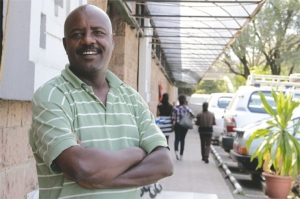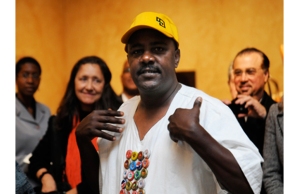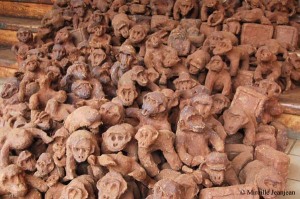Elias Sime – “Art Is My Life”
International acclaim and recognition is growing for the humble artist Elias Sime, whose Santa Monica Museum of Art exhibition brought strong emotion to those who saw it, offering him a deep satisfaction. “All that you touch you change. All that you change changes you,” goes the saying, something that resonates with the artist and describes his effect.
Tibebeselassie Tigabu – The Reporter
His life and work have inspired many, including the people behind Oscar winning film Little Miss Sunshine who made a documentary on him, and numerous curators describe him as the greatest artist of the time. His freshness and unconventional outlook is reflected in his work, using mediums such as threads, buttons, plastic, mud, straw, goat skin and animal horn. He has exhibited his work in many countries, under different titles including Eye of the Needle Eye of the Heart, Ants and Ceramics, Oedipus Rex Opera (a tale of the goddesses), What is Love and Gota tarat tarat. Recently he opened an exhibition entitled ‘Tightrope’, with pieces made from motherboards (the main circuit boards found in computers). Exhibiting at the Italian and German cultural institutions, Alliance Ethio-Francaise and the British council, the artists suggests that he is still excited about collecting motherboards. The huge pieces are composed of many colors and forms, with the patterns resembling cities as if you were looking from high above. The largest work is in the British Council, measuring four-and-a-half by 16 meters. Related to this exhibition and his career, Tibebeselassie Tigabu of The Reporter caught up with Elias Sime , to talk about his odyssey and the philosophy behind his work. Excerpts:
The Reporter: Where did this exhibition start and what is the thinking behind these pieces?
Elias Sime: Before doing a work there should be an initial point to start, but for all this to happen there should be passion and love.
The most pertinent thing in my work is touch; I want my work to touch people. Touch has its own effect and power; unfortunately we are losing it.
With all this technology, computers have an elusive effect – creating fake relationships. Within communication the anger, the passion, the resentment are lost in a way; it’s in vain.
There is definitely a gap. If I have to decode my motherboard pieces, they are like unknown cities, and at the same time cities that one is familiar with.
The technology has that effect, creating closeness at the same time as alienation and detachment.
The history in itself is interesting. When everything is consumed it has its own danger, and technology is somehow killing humanity as we know it. TVs and computers are taking over our lives, and that mysterious feeling of touch does not exist anymore. The family ties are breaking up. We are losing it; it is at the expense of humanity that we are gaining things. One size fits all is not a good strategy. So this piece passes on that message. This can be any city, and the plastic in the middle shows how life becomes routine. And the plastic shapes change, symbolizing the mood swings. It is like an image on a cloud, different for everyone.
What do the motherboards represent?
Motherboards look like cities – there are tales behind a city. Looking at the details of the motherboard, it is like the city or technology that we accept. When I first saw one piece of a motherboard 13 years ago, I experienced a shivering feeling that I cannot explain, and a special connection was created.
Over time I started collecting them, and it required patience, to get the same colors, to create the composition. It was not an easy process to collect them, and I rented an office to do it.
Getting a mobile phone or TV for the first time, the newness creates a feeling, and these have been used and it shows the touching. When I collect it was with an idea of a hope of tomorrow.
My life is art, there is no social life for me. The exhibition is not the last path, and when I find a new board I still get excited like the first time.
In my studio I have bigger pieces and a huge collection. It is very difficult that one day this will be trash; I get a shocking feeling. Even when they ask me what will happen to the artwork after the exhibition, I can’t imagine that day.
I give all my energy and love to my work, there is no half love. There might be hurt but it is OK to be vulnerable. I don’t think about what will happen to them at the end, I just do my work. And whenever exhibitions come around it becomes a headache. This work is about touching people.
This is not only my work; so many people contributed their energy. This is also the work of my sister/friend, the curator Meskerem Assegued, who gave me all the love and support I needed. It is a blessing for me to have her in my life. You cannot clap with one hand and she filled the void that existed. She sacrificed a lot for the art.
I believe in taking knowledge from everyone. I take knowledge in every step. Now we are researching on each board. It took years to collect and compose them, it needs passion, persistence and patience. This is what I took and put it in a form.
How was the collection process?
In many places, whenever I travel I collect. There are unwanted computers that are sent to Addis Ababa and sold per kilo. There are those who want the motherboards of mobile phones. It is usually on Sundays, especially when I get back from a field trip, that I go to places to see what I can find, I just get excited. Even though I don’t have any money, I borrow from Meskerem to buy them.
All my works are love work. Every piece I collect is new for me. It became an obsession; it is not good when you have this uncontrollable love, I think it is sickness. I am created for these.
How many computers do you think there are?
I can’t say. It is a lot. This exhibition is not only computers, but also collected mobile phone motherboards. It is open, you can have your own interpretation about anything, politics, life, it just becomes part of your soul. I like the touching and love part.
My family considers the materials I collect as trash; it only has a life for me, but I assumed it has a life for everyone. I just piled it in the house like it is normal, but it was not normal. My father supported me unconditionally, and he loved me unconditionally.
Years ago I was in a dilemma about what I wanted to do for a living. I told him that I was not doing what I wanted, and he made me promise to do what I wanted.
It is difficult to find this kind of father. I sold my car and it took me eight years to show my first exhibition. And also meeting Meskerem was a privilege. With my every development I show my father. I never think about money, if I don’t have it, I don’t have it.
I used to think borrowing from my family is normal, but I learned that it is not. My art sells rarely but I survive through miracles. When you break into the international market it has its own privileges.
Did you think the final result would turn out like it does in this specific exhibition?
I actually sketch, and what I truly understand is that I can’t actually sketch. They are not artistic; they are some kind of form.
It needs a talent that I guess I do not have, but I have a lot of sketches. I follow those; the patterns might not be conventional. I know what I want to do but I don’t know the exact form. There is nothing I throw away; I love my work so I see it through to perfection.
There is no display venue so you cannot stop to preview them. The piece is hung and wired onto a wood board. This is a puzzle, as is life. It just shows our daily life, interaction.
It is been a couple of years since you exhibited in this country, what was your previous exhibition?
‘Ants and Ceramics’ was my last show, which was also exhibited in the four cultural institutions. I think that was interesting. It’s very difficult to compare and contrast, but yeah, that was interesting.
It has anthropological research. The ants know communal life, which is amazing; they are small but the concept is big. They are very sharp, they support each other. Their power is amazing, and it’s the same with the ceramicists, they work in a communal way. Living that way is a must, and at the end they produce the most beautiful art work. Doing things communally is better.
It was tiresome, as everything had to be sewn. It was done with thread, clay mud and also wire.
Some of the works were memorable, like the ant that is looking in the mirror, which reflects on the people viewing.
You are renowned for your work with mud, especially the house that you repeatedly demolished. Are you still working with mud?
It is going good. I went Austria to do Gota, which is based around the people who live on the riverside of Abay, and their storage spaces for grain.
The storage area protects the grain from beetles and even rain…it is a very sophisticated technology, coming from ancient knowledge. It is mixed with animal dung and ash, so is completely natural.
Sadly we transformed it into plastic, which does not even protect it from grain beetles. The first ten pieces of Gota are in the Harla Art Center in Dire Dawa.
The mud house I was making actually changed ten times, by demolishing it and doing it all over again. It is all about love. It changes every day. When I see it I feel like modifying it, but when I give it to the Zoma Contemporary Art Center I stopped modifying it.
I was planning to make it into a studio. I am still homeless and travel between family members and friends to sleep. It became my home, and it was nice. All the stones are carved with different animals, which make you want to play with them. It gives you different feelings; it has meditation and soothing qualities. I didn’t think it would turn out like this.
Using a new medium, did it give you freedom?
Yeah very much, without doubt! I graduated in graphics but did not work with any of those, never getting a job in that field like I was supposed to. I have not done much painting; I was not created for that. My work is about touching people. I like to experiment with things. My art is like a wave, which is why water is not boring. I am created for this. Wisdom comes also through age. You get to think and contemplate.
When you practice things it gets better. If you don’t let out your ideas, it does not have any meaning. I understood this through my life. You get to learn things. I started with clothes, then moved on to woods, plastic, button, metal and pad locks. I don’t want to repeat things. There are so many new things that I want to do.
Now you have a very good reputation internationally, how is that for you?
I started doing exhibitions at the Dak’Art Biennale in 2004, and it went from there. I have an overwhelming feeling about it. In 2009 I did an exhibition at the Santa Monica Museum of Art, California, entitled ‘Eye of the Needle, Eye of the Heart’, which made me question if it was for me. After seeing my work one guy actually cried, and many told me it had a healing feeling from all the chaos. It represents many people.
Do you think your art is understood?
Whether you like it or not, it gets to people. One time I did an exhibition involving a parade of tiny monkeys, frogs and TV sets made out of mud; the monkey representing human beings, the frog the water world, and the TV all that we consume, and all that consumes us. I want everyone to love my art.
I was born in Cherkos, where the neighborhoods are connected. You get to learn, there is no choice but to love, you live on how to tolerate each other. If kids fight, it only stays that way for three minutes. The touching comes from that, villages raising children, passing everyone is related. This is also what the Little Miss Sunshine people did, they followed my life, my birth place, my daily routine. In many of the places I was overwhelmed; my works are perfection for me.
You don’t sell many of your artworks, how is it financially viable to live?
This is the thing that amazes me, it is a miracle for me to live. Money has never been an issue for me. Whenever my art sells it’s a good price, but I don’t want to hear about selling. Selling just kills some part of me. I deeply love them, but I have to sell them sometimes to survive.
What is the way forward?
Doing what I do with love. Until my last breath I want to do this. My dream is to see a big museum as an art center; I wish to see that.




November 26, 2013 at 5:03 am
I do too!
November 27, 2013 at 8:57 am
Keep up! You’re wonderful!